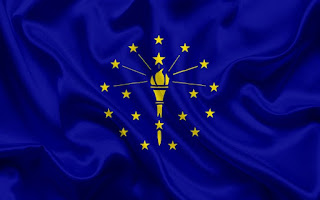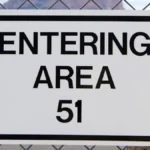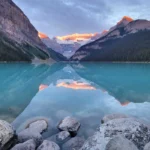
Indiana is located in the United States’ Great Lakes and Midwestern regions. Indiana is bordered by Michigan, Ohio, Kentucky, and Illinois. With 36,418 square miles, it is the 38th largest state in the United States. Indiana is the 16th most populous state, with a population of approximately 16,571,000 people. It is also the 16th most populous state. Paleo-Indians were the first to arrive in Indiana after the Ice Age, around 8000 BC. Until the arrival of Europeans in the 1600s, various cultures settled throughout Indiana’s region. The struggle for control of the area between British, French, and Native American tribes lasted until 1816, when Indiana became the Union’s 19th state.
Here are some interesting facts about Indiana:
- Name Origin: Indiana derives its name from its historical association with Native American tribes, meaning “Indian land” or “Land of the Indians.” This reflects the state’s rich indigenous heritage, as various tribes inhabited the region long before European exploration and settlement. The name symbolizes the cultural and historical significance of Native Americans in the area.
- French Exploration: The first French explorer to reach Indiana was Rene-Robert Cavalier, Sieur de La Salle, who arrived in South Bend in 1679. La Salle is known for his extensive explorations of the Great Lakes and the Mississippi River. His journey marked a significant moment in the history of Indiana, as it opened the region to further exploration and eventual European settlement.
- State Motto: Indiana’s state motto, “The Crossroads of America,” reflects its geographical significance as a transportation hub. The state is intersected by several major highways and railroads, making it a vital link for commerce and travel across the United States. This motto highlights Indiana’s role in connecting various regions and facilitating economic activity.
- Nickname: Indiana is commonly referred to as the “Hoosier State,” a nickname whose origins are debated. Some theories suggest it derives from the term “hoosier,” which may have referred to the rough and ready nature of early settlers. The nickname has become a source of pride for residents, embodying the state’s identity and cultural heritage.
- Capital and Largest City: Indianapolis serves as both the capital and the largest city of Indiana. Established in 1821, the city is known for its vibrant culture, diverse economy, and significant historical landmarks. Indianapolis is also famous for hosting major sporting events, including the Indianapolis 500, which is one of the most prestigious automobile races in the world.
- State Flower: The peony was designated as Indiana’s state flower in 1957. Known for its large, fragrant blooms and variety of colors, the peony symbolizes beauty and resilience. This flower is often associated with springtime and is a popular choice in gardens across the state, representing Indiana’s natural beauty.
- State Tree: The tulip tree, also known as Liriodendron tulipifera, is Indiana’s state tree, recognized for its impressive height and unique tulip-shaped flowers. This tree can grow up to 100 feet tall and is known for its straight trunk and distinctive foliage. The tulip tree has ecological significance, providing habitat for various wildlife species and contributing to the state’s forestry industry.
- State Bird: The cardinal, designated as Indiana’s state bird, is a vibrant and recognizable species known for its bright red plumage and cheerful song. Cardinals are year-round residents in Indiana, often seen in backyards and gardens. Their presence adds to the state’s natural beauty and serves as a symbol of warmth and joy.
- State Song: “On the Banks of the Wabash, Far Away” is the state song of Indiana, written by Paul Dresser in 1897. The song reflects the nostalgia and beauty of the Wabash River, which flows through the state. It captures the essence of Indiana’s landscape and the sentimental connection residents have to their home.
- Counties and Parks: Indiana is divided into 92 counties, offering a diverse range of communities and landscapes. The state is home to 23 state parks and 17 state historic sites, providing opportunities for outdoor recreation and historical exploration. These parks preserve Indiana’s natural beauty and cultural heritage, attracting visitors year-round.
- Rivers: Major rivers in Indiana include the Tippecanoe River, White River, Wabash River, and Ohio River. These waterways have played crucial roles in the state’s history, serving as transportation routes for trade and exploration. They also contribute to the state’s ecology and provide recreational opportunities such as fishing, boating, and hiking along their banks.
- Lakes: Indiana boasts significant lakes, including Lake Michigan and Mississinewa Lake. Lake Michigan, with 41 miles of Indiana shoreline, is a popular destination for beachgoers and water sports enthusiasts. Mississinewa Lake, a man-made reservoir, offers recreational activities like fishing, camping, and hiking, enhancing the state’s outdoor appeal.
- Agriculture: Agriculture is a cornerstone of Indiana’s economy, with the state producing a variety of crops and livestock. Key agricultural products include soybeans, wheat, rye, oats, onions, tomatoes, poultry, and hogs, with corn being the primary crop. Indiana ranks among the top states in agricultural production, reflecting its rich farmland and favorable growing conditions.
- Industrial Center: Indiana is recognized as one of the world’s most important industrial centers, contributing significantly to the production of oil, steel, and iron products. The state’s industrial sector has a long history, dating back to the early 20th century when manufacturing began to flourish. Indiana’s strategic location, coupled with its extensive transportation network, has attracted numerous industries, making it a vital player in the national and global economy. The industrial diversity in Indiana supports thousands of jobs and plays a critical role in the state’s economic stability.
- Limestone Production: Indiana is a leading producer of limestone in the United States, known for its high-quality stone that is used in construction, road building, and various industrial applications. The state’s limestone quarries, particularly in the southern region, have been operational for over a century, supplying materials that contribute to infrastructure development across the country. The limestone industry is a significant contributor to Indiana’s economy and showcases the state’s geological resources.
- Lewis and Clark Expedition: The famous explorers Lewis and Clark set out from Fort Vincennes, Indiana, in 1803 to explore the Northwest Territory. This expedition, commissioned by President Thomas Jefferson, aimed to map the newly acquired lands and establish trade routes. Fort Vincennes served as a crucial starting point for their journey, which ultimately expanded knowledge of the American West and facilitated westward expansion.
- Raggedy Ann Doll: The beloved Raggedy Ann doll was invented by Marcella Gruelle in Indianapolis in 1914. Gruelle created the doll based on a character from a story she wrote for her daughter. The doll quickly gained popularity and became a classic toy, symbolizing childhood innocence and imagination. Today, Raggedy Ann remains a cherished figure in American culture, with a legacy that continues through books, merchandise, and nostalgic memories.
- Santa Claus, Indiana: Each year, more than 500,000 letters to Santa are sent to Santa Claus, Indiana, particularly during the Christmas season. This unique tradition has made the town famous, attracting visitors who want to experience the holiday spirit. The local post office even has a special program to respond to children’s letters, making it a magical destination for families and a testament to the town’s festive charm.
- Covered Bridge Capital: Historic Parke County is known as the Covered Bridge Capital of the World, home to 32 covered bridges. These architectural gems date back to the 19th century and are celebrated for their beauty and craftsmanship. The county hosts an annual Covered Bridge Festival, drawing visitors who appreciate the history and scenic views these bridges provide, as well as the picturesque landscapes of rural Indiana.
- Indigenous Tree Species: Indiana is home to more than 100 indigenous tree species, showcasing a diverse range of flora. Prior to European settlement, approximately 80% of the state was covered in forest, providing vital habitats for wildlife and contributing to the ecological balance. However, this figure has decreased to around 17% due to urbanization and agricultural development. The remaining forests are crucial for conservation efforts and serve as important recreational areas for residents.
- John Dillinger Escape: In 1934, notorious gangster John Dillinger famously escaped from Lake County Jail in Crown Point, Indiana. Using a pistol fashioned from wood, Dillinger orchestrated a daring escape that captured national attention. His exploits made him a legendary figure in American crime history, and the incident highlighted the vulnerabilities of law enforcement during that era, leading to increased security measures in jails across the country.
- Gatling Gun Invention: Richard Gatling invented the rapid-fire machine gun in Indianapolis in 1862. His invention, known as the Gatling gun, was one of the first successful machine guns and represented a significant advancement in military technology. The Gatling gun was used during the American Civil War and influenced future firearm designs. Gatling’s contributions to weaponry and engineering have left a lasting impact on both military history and technological innovation.
- Pan American Games: In 1987, Indianapolis hosted the Pan American Games, a major international multi-sport event featuring athletes from across the Americas. This event marked a significant moment in the city’s history, showcasing its capacity to host large-scale sporting events. The successful organization of the games helped to elevate Indianapolis’s profile as a sports city and demonstrated the community’s commitment to athletic excellence and hospitality.
- Indianapolis Motor Speedway: The Indianapolis Motor Speedway, which hosted the first long-distance car race in 1911, is renowned for its iconic status in the world of motorsports. The speedway is home to the Indianapolis 500, held annually on Memorial Day weekend, which is one of the oldest and most prestigious automobile races in the world. The event attracts hundreds of thousands of spectators and has become a significant part of Indiana’s cultural identity, celebrating the state’s rich automotive history and passion for racing.
Frequently Asked Questions about Indiana:
1. What is Indiana known for?
Indiana is known for several key features, including its rich agricultural landscape, the Indianapolis 500 (a famous automobile race), and its contributions to the manufacturing industry. The state is also recognized for its historical significance in the Underground Railroad, as well as its diverse cultural heritage, including festivals and local cuisine.
2. What are the major cities in Indiana?
The major cities in Indiana include:
- Indianapolis: The state capital and the largest city, known for its sports events and cultural institutions.
- Fort Wayne: The second-largest city, known for its parks and vibrant arts scene.
- Evansville: Located in the southwestern part of the state, it’s known for its riverfront and historical significance.
- South Bend: Home to the University of Notre Dame and known for its rich history and education.
3. What is the climate like in Indiana?
Indiana experiences a humid continental climate, characterized by four distinct seasons. Summers can be hot and humid, with temperatures often exceeding 90°F (32°C), while winters can be cold, with temperatures frequently dropping below freezing. Rainfall is distributed fairly evenly throughout the year.
4. What are some popular tourist attractions in Indiana?
Some popular tourist attractions include:
- Indianapolis Motor Speedway: The venue for the Indianapolis 500 race.
- Indiana Dunes National Park: Known for its beautiful beaches and hiking trails along Lake Michigan.
- The Children’s Museum of Indianapolis: The largest children’s museum in the world, offering interactive exhibits.
- Brown County State Park: Famous for its scenic views, hiking, and fall foliage.
5. What is the history of Indiana?
Indiana became the 19th state of the United States on December 11, 1816. The state played a significant role during the westward expansion and was a key location in the abolitionist movement. The state has a rich Native American history, and various tribes, including the Miami and Potawatomi, originally inhabited the area.
6. What is the economy of Indiana like?
Indiana has a diverse economy, with key sectors including manufacturing, agriculture, and services. The state is one of the top producers of corn and soybeans in the U.S. Additionally, it has a strong automotive industry and is home to several major corporations.
7. What are the educational institutions in Indiana?
Indiana is home to several well-known educational institutions, including:
- Indiana University: A major public research university with multiple campuses, including its flagship campus in Bloomington.
- Purdue University: Known for its engineering and technology programs, located in West Lafayette.
- University of Notre Dame: A prestigious private Catholic university located in South Bend.
8. What outdoor activities can you do in Indiana?
Indiana offers a variety of outdoor activities, including:
- Hiking and camping in state parks like Brown County and Turkey Run.
- Fishing and boating on Lake Michigan and various rivers and lakes.
- Biking on the extensive trails throughout the state, including the Monon Trail.
9. What is the cultural scene like in Indiana?
Indiana has a vibrant cultural scene, with numerous museums, theaters, and music festivals. The state hosts events like the Indiana State Fair and the Indianapolis Artsgarden, which showcases local artists. Additionally, there are many historical sites and cultural festivals celebrating Indiana’s diverse heritage.
10. How do I get to Indiana?
Indiana is accessible by various means of transportation. Major highways, including Interstate 65, Interstate 70, and Interstate 69, connect the state to neighboring regions. The Indianapolis International Airport serves as the primary airport, with numerous domestic and some international flights. Additionally, Amtrak provides train services to several cities in Indiana.










Reading your post was like taking a mini-vacation from reality – it was engaging, thought-provoking, and so much fun! Your writing is truly a gift to the world.